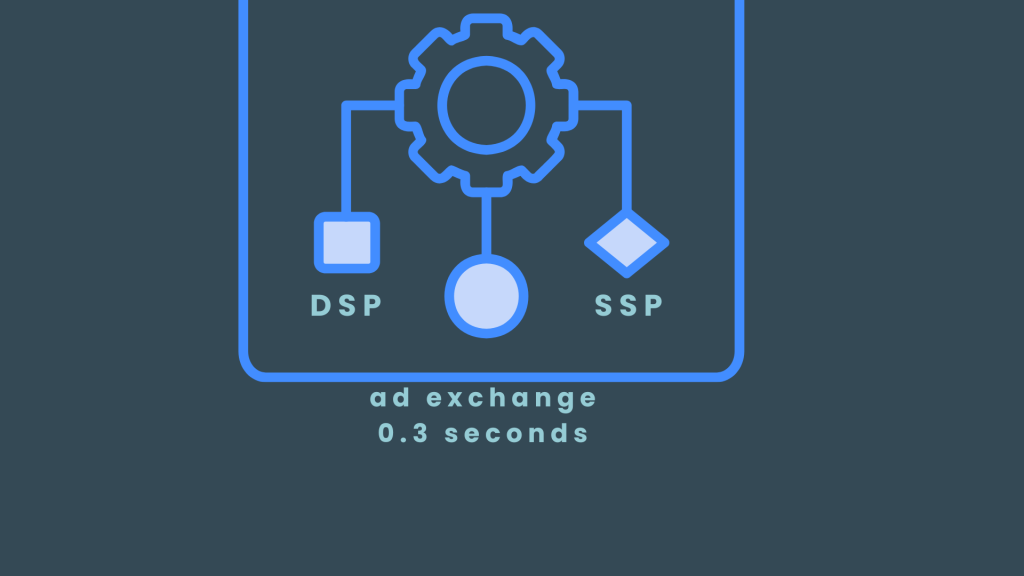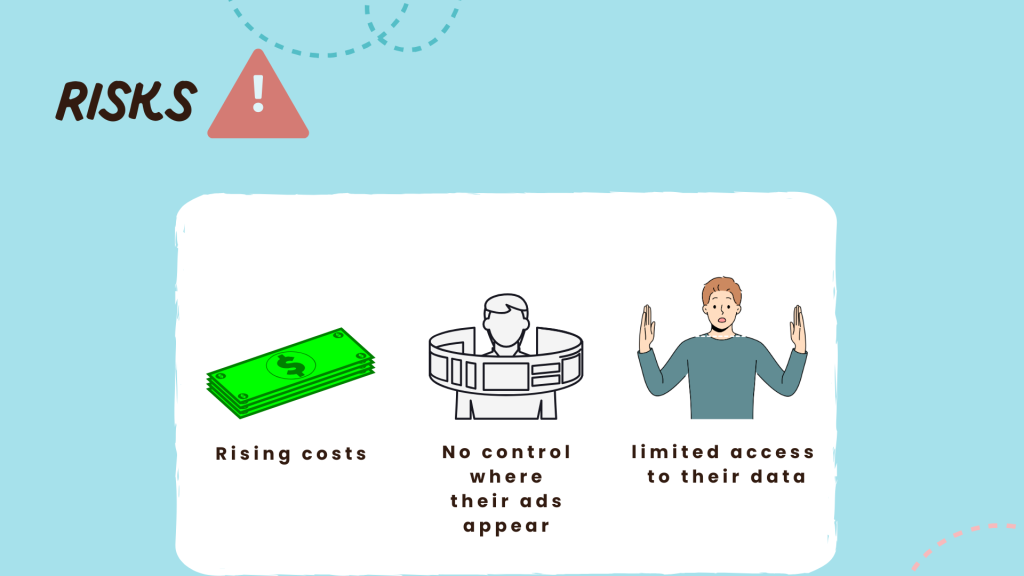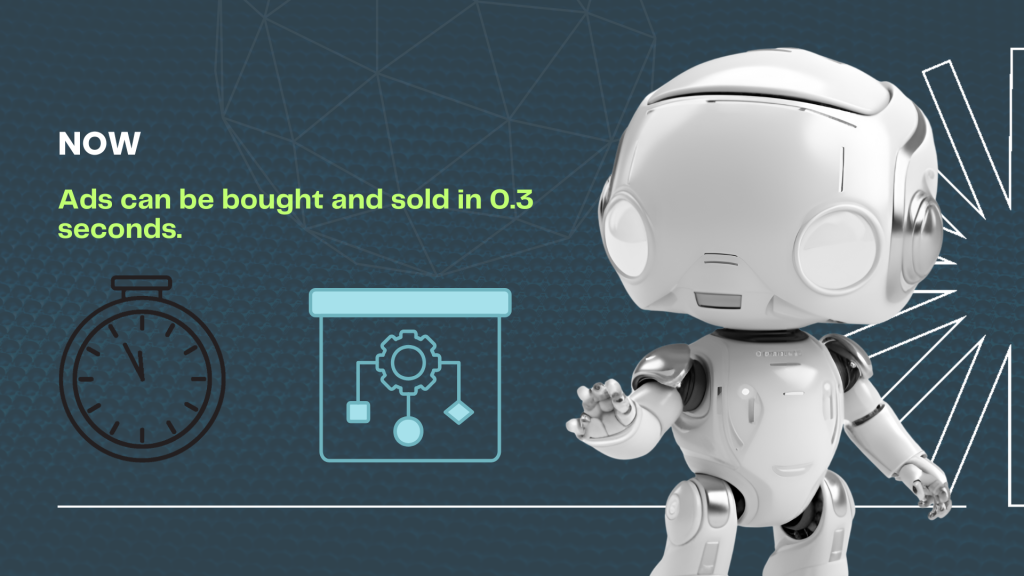What is programmatic advertising and how does it work? well, it’s a new way of buying and selling ads. Instead of trying to manually figure out where to put an ad, an automated system does it all by itself in a matter of seconds.

Imagine this, you’re reading a random article online and suddenly you see this ad placed in front of you with a special offer on the exact same shoes you’ve been dying to have for more than a week now, the same color you wanted, the same design and even with a 10% off! Your immediate thought would be: how is this website reading my mind? However, it’s just programmatic advertising.
What is Programmatic Advertising?

Selling and buying ads used to take more time and effort, but now it has evolved significantly. Automation has taken over, replacing the traditional method where advertisers negotiated directly with websites and platforms. Programmatic advertising now uses advanced software to automatically purchase ad space in seconds, based on specific criteria. This process not only saves time, but it also optimizes targeting, ensuring that ads reach the right audience at the perfect moment. It is considered as the most effective tool in the digital world (Lemoine, 2024)
How does programmatic advertising work?
When you are waiting for a page to load, in those 0.3 seconds, there’s an auction happening behind the scenes where ads are being bought and sold. There are three steps to this very fast process:

Demand side: On the demand side, advertisers who already have a defined target audience based on certain criteria (age, interests) use demand side platforms (DSP) to find this audience, which is just a fancy name for it so don’t be too hard on yourself if technical words aren’t for you!
Real time bidding: On this side, ads are bought and sold in real time like in auctions, as a result, the advertiser with the highest bid gets their ad placed!
Supply side: On the supply side, publishers aim to sell all their advertising space for the highest price they can get (Ungureanu, Belaşcu, Horobeț, & Croitoru, 2023). They use supply side platforms (SSP) to ensure that the ad is shown to the right audience.
The GAFAM effect
Companies who rely on GAFAM for their programmatic advertising have noticed that they don’t have control over where their ads appear (Lemoine J. F.-G., 2024), which could possibly affect their brand safety. Additionally, considering the costly price companies have to pay, it doesn’t seem right to them that they don’t have access to their ad performance data.Therefore, This is exactly why nowadays many companies are looking to detach from GAFAM.
Independence from GAFAM
Advertisers nowadays aim to use independent programmatic platforms, these platforms focus on transparency, they share the data with companies about their ads performance and they also give great importance to brand safety.
Disadvantages of using GAFAM

- High costs: Prices are not only high but they’re also very unpredictable due to complex bidding structures.
- Reduced transparency: Advertisers often don’t know where their ads are being placed, this can highly affect their brand image.
- Limited access to data: This also raises privacy concerns as companies don’t have access to their campaign performance data.
- Limited customer support: Companies might not get replies in real time, and mostly the replies are automatic. Therefore, this can be very frustrating for companies.
- Inflexibility in campaign strategies: GAFAM may have fixed systems which will limit the creativity of the advertisers’ campaigns.
Advantages of using independent programmatic platforms
- Less pricey: They usually offer cost effective and competitive pricing. Consequently, this allows companies to maximize their return on investment by spending less on ads.
- Less fraud: Their ads are highly targeted due to multiple partnerships, which means that if advertisers pay for their ad to be shown in 30 websites it’s going to be shown in those 30 authentic websites that match exactly with their target audience.
- More control over where the ads show: Thanks to independent programmatic platforms, companies have more control over where their ads show. In other words, their ads won’t show on the websites that are on their blacklist like war news articles.
- Access to data about campaign performance: These platforms often provide the companies with data reports about their campaign effectiveness (click-through rates, conversion rates), as a result, this allows them to make decisions that optimize their strategy in real time.
- Brand safety: This basically is their top one priority. They have algorithms that deny any unrecognized website, and they also have partnerships with third party verification tools which will make sure that the ads are displayed in safe environments.
The future of programmatic advertising
The digital world advances so fast and all possibilities are open. It’s crazy to think that in the 1990s people didn’t have full access to the internet however now we are talking about programmatic advertising and artificial intelligence. And what’s coming next is going to be unthinkable. These mind-blowing advancements in technology are expected to take programmatic advertising into an advanced era of emerging it with enhanced artificial intelligence as well as virtual reality.
Sources:
Samuel, A., White, G. R. T., Thomas, R., & Jones, P. (n.d.). Programmatic advertising: An exegesis of consumer concerns. Computers in Human Behavior, 116. https://doi.org/10.1016/j.chb.2020.106657
Ungureanu Andrei, Belaşcu Lucian, Horobeț Alexandra, & Croitoru Ionuț Marius. (2023). Programmatic Advertising and Online Publishers: The Case of Libertatea.Ro. Studies in Business and Economics, 18(3), 306–321. https://doi.org/10.2478/sbe-2023-0060
Ciuchita, R., Gummerus, J. K., Holmlund, M., & Linhart, E. L. (n.d.). Programmatic advertising in online retailing: consumer perceptions and future avenues. Journal of Service Management, 34(2), 231–255. https://doi.org/10.1108/JOSM-06-2021-0238
Lemoine, J. F., & Mercanti-Guérin, M. (2024). Expert opinions: Is digital still an effective communication tool for advertisers? Myths and realities. Journal of Marketing Trends, 8(2) https://hal.science/hal-04471680/
Busch, O. (2016). Programmatic advertising: the successful transformation to automated, data-driven marketing in real-time. Springer. https://doi.org/10.1007/978-3-319-25023-6
https://arago.com/en/blog/full-stack-and-independent-programmatic-platform-alternative-to-gafam
